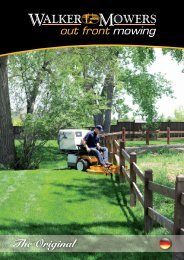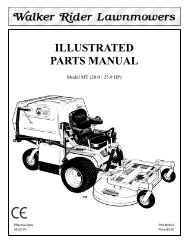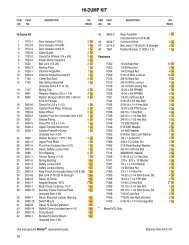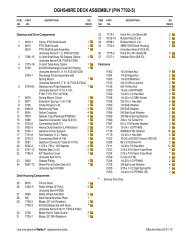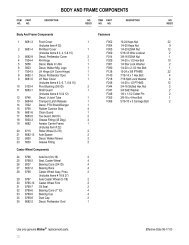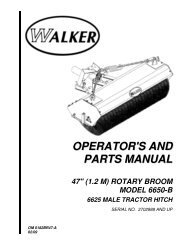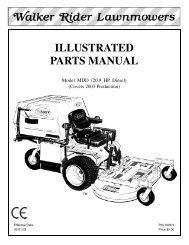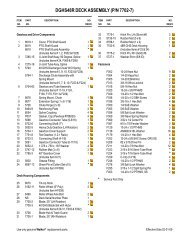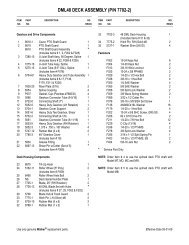1998 S/N 21329 - Walker Mowers
1998 S/N 21329 - Walker Mowers
1998 S/N 21329 - Walker Mowers
You also want an ePaper? Increase the reach of your titles
YUMPU automatically turns print PDFs into web optimized ePapers that Google loves.
Assembly Instructions<br />
PREOPERATING CHECKLIST<br />
Before operating the mower for the first time, and as<br />
a routine before daily operations, it is important to<br />
make sure the mower is properly prepared and<br />
ready for operation. The following is a list of items to<br />
be checked. (For a mower with frequent operation,<br />
some of these items will not need to be checked every<br />
day, but the operator should be aware of the<br />
condition of each.)<br />
For proper fuels and lubricants refer to Specifications.<br />
FILL FUEL TANK<br />
Fill the fuel tank using clean, fresh automotive<br />
grade unleaded gasoline (87 octane rating minimum).<br />
DANGER<br />
Handle gasoline with care. Gasoline is<br />
highly flammable and its vapors are explosive.<br />
Use safe refueling procedures:<br />
• DO NOT fill fuel tank with the engine running.<br />
• If the engine is hot, allow to cool before<br />
refueling.<br />
• Use an approved fuel container.<br />
• Fuel the mower outdoors.<br />
• DO NOT smoke while refueling.<br />
• Avoid spilling fuel; use a funnel or<br />
spout.<br />
• DO NOT overfill the fuel tank; fill up to<br />
about 1 in. (25 mm) below the top of tank.<br />
IMPORTANT: DO NOT permit dirt or other foreign<br />
matter to enter the fuel tank. Wipe dirt from around<br />
the filler cap before removing. Use a clean fuel storage<br />
container and funnel.<br />
IMPORTANT: DO NOT mix oil with gasoline. Always<br />
use fresh, automotive grade gasoline. DO<br />
NOT use premium, white, or high-test gasoline. DO<br />
NOT use additives, such as carburetor cleaners, deicers,<br />
or moisture removing agents. DO NOT use<br />
gasoline blended with methyl alcohol.<br />
CHECK ENGINE CRANKCASE OIL LEVEL<br />
Check the engine crankcase oil level before use and<br />
after each 5 hours of continuous operation. Refer<br />
to LUBRICATION for Checking Engine Crankcase<br />
Oil Level in Maintenance Instructions.<br />
CHECK AND SERVICE ENGINE AIR CLEAN-<br />
ER SYSTEM<br />
• Check air restriction gauge to make sure there is<br />
no red indication showing.<br />
• Check condition, cleanliness, and security of the<br />
complete air cleaner system (clean primary air<br />
filter every 100 hours). For detailed procedures,<br />
refer to CLEANING the Engine Air<br />
Cleaner System in Maintenance Instructions.<br />
ADJUST CARBURETOR (Initial Start-up Only)<br />
Refer to ADJUSTMENTS of Carburetor in Maintenance<br />
Instructions.<br />
CHECK ENGINE COOLING SYSTEM<br />
Check that the engine cooling air intake screen is<br />
free of obstruction by grass clippings or debris and<br />
clean if required. Also, cylinder head cooling fins<br />
should be inspected and cleaned if any build-up of<br />
debris is noted [remove two (2) cylinder head access<br />
panels to inspect and clean].<br />
Check performance of the cooling system by starting<br />
the engine, holding a hand adjacent to the cylinder<br />
heads, and feeling the cooling airflow.<br />
DANGER<br />
Make sure to keep hands clear of exhaust<br />
pipe, muffler, and moving parts when<br />
checking airflow.<br />
21



